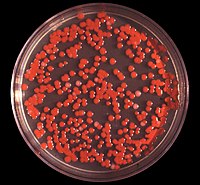
Photo from wikipedia
The existence of quorum sensing (QS) and quorum quenching (QQ) plays important roles in biofilm formation. However, direct detection of QS ability is difficult due to the low concentrations of… Click to show full abstract
The existence of quorum sensing (QS) and quorum quenching (QQ) plays important roles in biofilm formation. However, direct detection of QS ability is difficult due to the low concentrations of signal molecules inside the biofilm. Therefore, QQ activity is typically used to indicate the attribution of QS/QQ to the biofilm. Nevertheless, current detection methods of QQ activity based on biosensors present undesirable operability and accuracy. In this study, the 96-well plate assay based on a specific biosensor, Agrobacterium tumefaciens A136, and a colorimetric substance, X-gal was established. The reliable fitting results were obtained by standardizing the composition of the A136 X-gal assay solution and optimizing the operating conditions. This method improved the accuracy of QQ activity detection and reduced time and cost consumption. Finally, the 96-well plate assay was successfully applied to detect the QQ activities of biofilm samples and explore possible environmental influencing factors. In general, this study provided a new strategy for understanding the QQ effect in biofilm systems.
Journal Title: Chemosphere
Year Published: 2023
Link to full text (if available)
Share on Social Media: Sign Up to like & get
recommendations!